
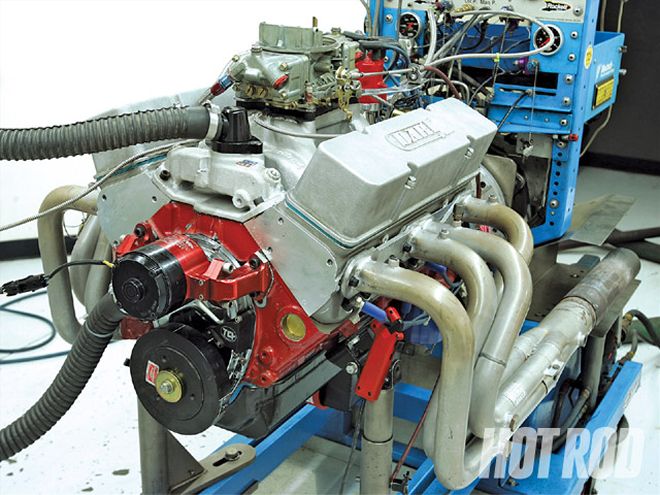 Here's our little 360ci Chevy on the dyno at Westech; this is from baseline tuning runs before the individual cylinder monitoring was installed.
Here's our little 360ci Chevy on the dyno at Westech; this is from baseline tuning runs before the individual cylinder monitoring was installed.
We hear it all the time: "You shouldn't run nitrous on a dual-plane intake manifold." But it's our job to ask why. We did, then we tested it, and the results are right here for your perusal.
We've heard three reasons why guys claim you should not use a plate-type nitrous system sandwiched between the carburetor and a dual-plane manifold. The first is that the raised half of the plenum is too close to the spray bars, so the nitrous and fuel will bounce off the intake floor. The second claim is that cylinder-to-cylinder distribution is so poor with a dual-plane that you don't want to run the risk of one cylinder running lean during nitrous operation. Of course, the third reason is guys say you just can't make the power with a nitrous'd dual-plane.
But is it true? To find out, we took a typical small-block Chevy and ran it on the dyno, feeding it 180hp nitrous hits through an NOS Big Shot plate system. First we tried it with an Edelbrock Victor Jr. single-plane, then with an Edelbrock Air-Gap dual-plane. We employed an Innovate Motorsports data-collection system that allowed us to read the air/fuel ratio in each cylinder via oxygen sensors placed in each header tube. All testing was done with Rockett Brand 100-octane unleaded gas.
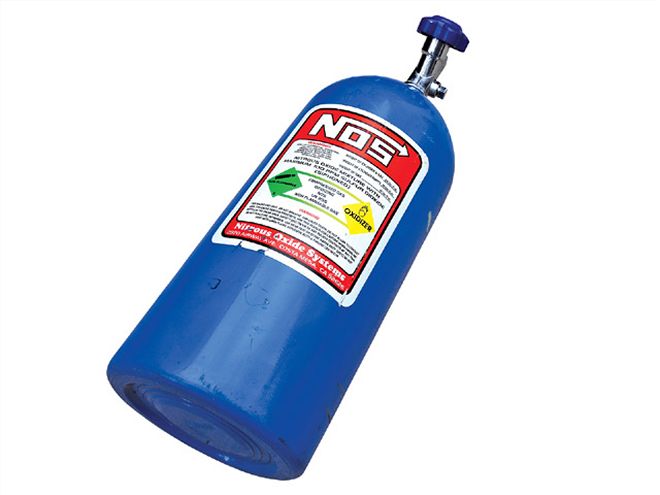
The engine itself had to be the kind of street/strip mill on which you'd prefer to run a dual-plane intake, but might consider yourself forced to run a single-plane if you felt like spraying it once in a while. It could not be so radical that using a single-plane was a forgone conclusion, but it had to be tame enough that a typical guy might not ever want to hose more than the 180 hp worth of nitrous.
Therefore, the victim was a 0.060-inch overbored 350 with a stock cast crank, Probe forged pistons and 6.00-inch rods, 11.25:1 compression, Dart 215cc aluminum heads, Comp Cams 1.5:1 roller rockers, a Comp 294S solid flat-tappet cam (248/ 248 at 0.050, 0.525/0.525 lift, and 110-degree lobe-separation angle), and MSD ignition. The headers had 1 3/4-inch primaries and 18-inch collector extensions. The carb used for both intake manifolds was a Holley 750 double-pumper.
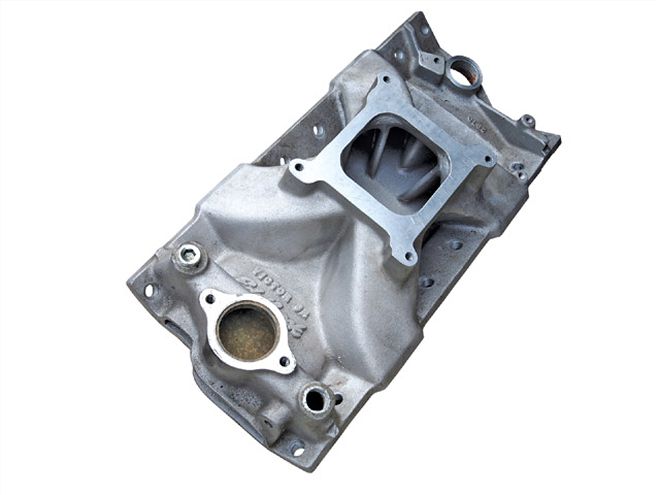
Naturally aspirated, the combo with the Air-Gap intake made 433 lb-ft at 4,700 rpm and 452 hp at 6,200. The Victor Jr. delivered 427 lb-ft at 5,000 rpm and 460 hp at 6,400. As you can see by the graph in this story, we got the predictable outcome: The dual-plane made a bit more bottom end and the single-plane shined at higher rpm.
But what about on nitrous? To keep testing accurate, we ran only full nitrous bottles heated to achieve 1,000 psi. The same fuel pressure and jetting was used, so the intake manifolds themselves were the only variable. We set the MSD box to pull out 5 degrees of timing when the nitrous was engaged.
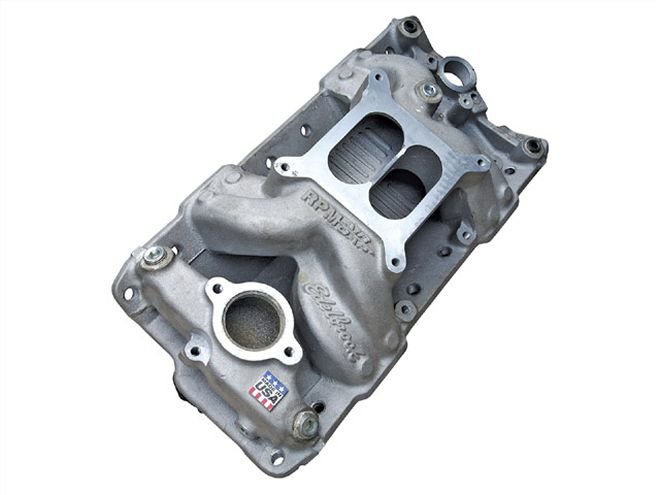
Both intakes performed nearly identically on nitrous, making about 630 hp on the button. If anything, the dual-plane was better below 5,500 rpm, and the Victor Jr. had a very slight advantage only above 5,800 rpm. More interestingly, the cylinder-to-cylinder air/fuel ratios on nitrous were actually much closer with both intakes than they were naturally aspirated. Basically, if you aren't already lying awake at night fretting about individual cylinder ratios with your naturally aspirated dual-plane, then you certainly don't need to when spraying reasonable amounts of nitrous. It only improves. Really.
There are more absurd applications of nitrous where a dual-plane intake would probably become a problem, but they are with engines that would never be optimal with one anyway. For average street/strip use with mild plate systems, we're confident you can call BS on the old street talk.
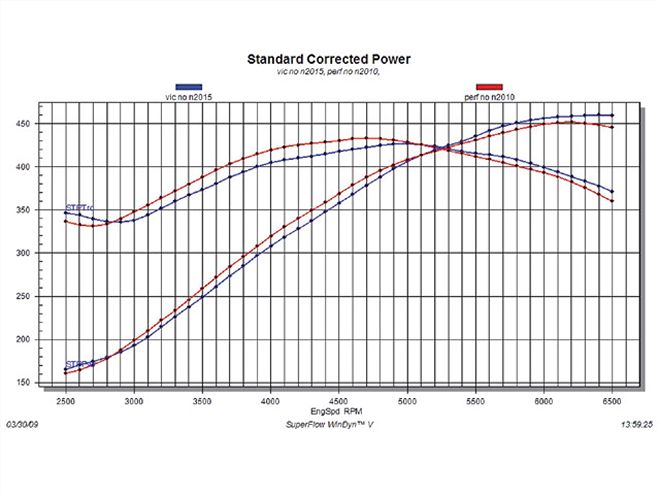
This graph shows the naturally aspirated performance of the engine with the Air-Gap dual-plane (red lines) compared with the Victor Jr. single-plane (blue lines). The intake you'd choose would depend on if your priority was street or strip, how heavy the car is, and what gears and converter you have.
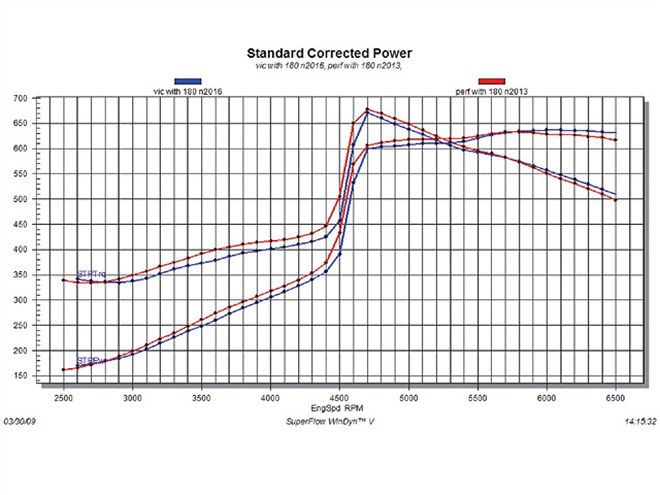
This is what it looks like when you hit the nitrous at 4,400 rpm. The Air-Gap curve (red lines) is actually just a little better than the Victor Jr. (blue lines) up to 5,000 rpm, then the Victor starts to outflow it above 5,800. Regardless of the intake, the power gain with nitrous was almost exactly 180 hp. There's nothing here that says the dual-plane is junk when used with nitrous.